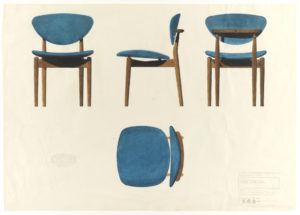This mid-twentieth century shopping bag celebrates an icon of Danish Modern furniture design. The bag, created in 1949 by Mike Romer and Ida Fabricius, is embellished with a boldly rendered illustration of the Chieftain chair (Høvdingestolen), designed in that same year by Danish architect and furniture designer Finn Juhl. With its dramatically curved leather upholstery and exposed teakwood frame, Juhl’s Chieftain chair represents a rejuvenation of Danish Modern furniture design—here, it is depicted on the modest brown paper of an inexpensive shopping bag intended for the everyday consumer.
The lofty chair pictured on the bag combines a wide seat and shield-shaped back with graceful, biomorphic curves, an avant-garde form for the period, characterizing a shift away from austere functionalism. The display of Juhl’s design on a simple paper bag emphasizes the grandiose chair as a new frontrunner in Danish Modernism, clearly celebrating the designer, manufacturer, and the chair’s materials, appearing in typeface on the bag’s lower left corner. This inexpensive shopping bag advertises a contemporary teak and leather chair that was, by contrast, unaffordable to the middle class consumer.
In 1948, the Museum of Modern Art’s Director of Industrial Design, Edgar Kaufmann, Jr. visited Denmark’s Cabinetmakers Guild Exhibition in search of standouts in Danish design. However, Kaufmann left Denmark “less than impressed.”[1] Juhl designed the Chieftain chair for the following year’s exhibition, executed by master craftsman Niels Vodder. The Chieftain chair, with its dignified back emulating an elegant detachment from its ergonomic armrests and curvaceous seat, sparked a renewed interest in contemporary Danish furniture.

The shopping bag is one of two objects showcasing Juhl’s designs in the Cooper Hewitt collection. A drawing for a dining chair displays his attention to detail. It also highlights the distinct separation of chair seat and back characteristic of his furniture. Juhl’s work evokes the striking sculptural forms found in modern art of the era.[2] Juhl is commonly referred to as the Father of Danish Modernism, due to his pioneering furniture shapes and attentiveness to creating functional and artistically expressive pieces.[3]
The Chieftain Chair can be viewed online in a virtual tour of Finn Juhl’s House: https://ordrupgaard.dk/en/portfolio_page/architecture/
Rachel Pool Fillhouer is a second-year graduate student in the History of Design and Curatorial Studies program offered jointly by the Parsons School of Design and the Cooper Hewitt, Smithsonian Design Museum. She is a Fellow in the museum’s Drawings, Prints & Graphic Design Department.
[1] Mussari, Mark, Danish Modern: Between Art and Design (London, United Kingdom: Bloomsbury, 2016), 63–76.
[2] “Chieftain Chair 1949,” House of Finn Juhl, accessed October 28, 2019,
https://finnjuhl.com/collection/chieftain-chair
[3] Mussari, ibid.
